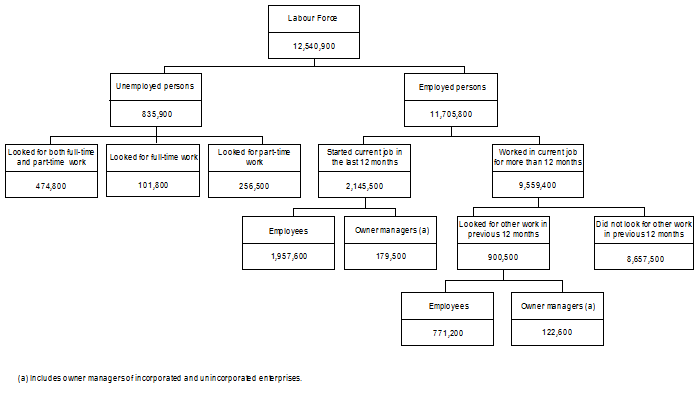JOB SEARCH EXPERIENCE
The Job Search Experience (JSE) topic presents information about the experiences of unemployed persons in seeking work, in terms of the steps they have taken to find work and the difficulties they encountered. JSE also provides information about employed persons who started their current job in the previous 12 months and the steps they took to look for work or more hours.
The framework below contains information on three mutually exclusive groups:
- unemployed persons;
- employed persons who started their current job in the previous 12 months; and
- persons employed for more than a year in their current job who looked for work in the previous 12 months.
 UNEMPLOYED PERSONS
UNEMPLOYED PERSONS
Almost three quarters (74%) of unemployed persons in February 2015 had been looking for work for less than one year. A further 15% had been looking for work for between 1 and less than 2 years, and the remaining 11% had been looking for work for 2 years or more.
The most commonly reported main difficulties
1 in finding work for unemployed persons looking for less than 1 year were:
- too many applicants for available jobs 20%;
- no vacancies in line of work 10%; and
- no vacancies at all 8%. (Table 26)
The most commonly reported main difficulties
1 in finding work for unemployed persons looking for 1 year or more were:
- too many applicants for available jobs 20%;
- insufficient work experience 13%; and
- own ill health or disability 12%. (Table 26)
Of unemployed persons 11% did not have any difficulty in finding work.
The most common steps taken to find work reported by unemployed persons were:
- looked at advertisements for jobs on the Internet, in a newspaper or on noticeboards 88%;
- wrote, phoned or applied in person to an employer for work 84%;
- answered an advertisement for a job on the Internet, in a newspaper or on noticeboards 72%; and
- contacted friends or relatives 54%. (Table 21)
Over one third (38%) of unemployed persons were aged 15–24 years compared to 23% aged 45 years and over.
Other characteristics of unemployed persons were:
- 13% had at least one offer of employment in their current period of unemployment;
- 17% had never worked before; and
- 87% had not received a job offer. (Table 27)
EMPLOYED PERSONS WHO STARTED THEIR CURRENT JOB IN THE PREVIOUS 12 MONTHS
There were 2.1 million job starters (employed persons who started their current job in the previous 12 months). Of these, 91% were employees, 3% were owner managers of incorporated enterprises and 6% were owner managers of unincorporated enterprises.
Of employee job starters:
- 53% were males;
- 58% were full-time workers, of whom 63% were males; and
- 19% were Professionals. 23% of males were Technicians and trades workers, while 22% of females were Professionals. (Table 28)
PERSONS EMPLOYED FOR MORE THAN A YEAR IN THEIR CURRENT JOB AND LOOKED FOR WORK
There were 900,500 persons employed for more than a year in their current job who looked for work in the previous 12 months. Of these:
- 48% were full-time workers;
- 25% were aged 25–34 years;
- 86% were employees; and
- 10% checked or registered with a Job Services Australia provider. (Table 29)
The most common reasons for looking for other work while still employed were:
- wanted better pay (45%) (48% for males and 42% for females);
- wanted more hours for 51% of those aged 15–24 years; and
- wanted better conditions/flexibility/work life balance 28%. (Table 29)
The most common steps taken to look for work or more hours were:
- looked at advertisements for jobs on the Internet, in a newspaper or on noticeboards (79%);
- wrote, phoned or applied in person to an employer for work (65%); and
- answered an advertisement for a job on the Internet, in a newspaper or on noticeboards (56%). (Table 29)
End Note: 1. Reported difficulties in finding work refer to respondents perception in the reasons for not being able to find work.
 Quality Declaration
Quality Declaration  Print Page
Print Page
 Print All
Print All